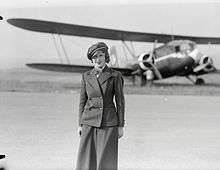1934 Swissair Tuttlingen accident
 A YC-30, similar to the accident aircraft | |
| Accident summary | |
|---|---|
| Date | 27 July 1934 |
| Summary | In-flight wing separation in severe weather conditions |
| Site | Near Tuttlingen, Germany |
| Passengers | 9 |
| Crew | 3 |
| Fatalities | 12 (all) |
| Survivors | 0 |
| Aircraft type | Curtiss AT-32C Condor II |
| Operator | Swissair |
| Registration | CH-170 |
| Flight origin | Zurich Airport, Switzerland |
| Stopover | Stuttgart Airport, Germany |
| Last stopover | Leipzig/Halle Airport, Germany |
| Destination | Berlin Tegel Airport, Germany |
The 1934 Swissair Tuttlingen accident occurred on 27 July 1934 when a Swissair Curtiss AT-32C Condor II aircraft crashed near Tuttlingen, Germany while flying through a thunderstorm, killing all 12 people on board. It was the worst air crash in 1934[1] and Swissair's first aviation accident since its foundation in 1931.[2]

Aircraft and occupants
The aircraft involved in the accident, registered CH-170, was a Curtiss AT-32C Condor II, a variant of the standard T-32 developed specifically for Swiss flag carrier Swissair, which was its only operator. CH-170 had entered service on 28 March 1934 and, by the time of the accident, had only been in service for four months. The cabin was configured with seating for up to 15 people.[3]
The aircraft's flight attendant, Nelly Diener, also known as the Engel der Lüfte ("Angel of the Skies"), is notable for being Europe's first air stewardess. She had been working for Swissair since 1 May 1934. The other two crew members were the pilot, Armin Mühlematter, and the radio navigator, Hans Daschinger. On the accident flight, there were nine passengers aboard.[3][4]
Accident
The aircraft departed Zurich for Berlin, with stopovers in Stuttgart and Leipzig. Shortly after crossing the Swiss-German border, the aircraft, cruising at an altitude of about 3,000 meters, encountered a thunderstorm, and while flying through it, the right wing eventually broke off. This resulted in an immediate loss of control and the aircraft plummeted into a forest near Tuttlingen, exploding into flames on impact.[3][5][6]
Investigation
Investigators found that oscillations in the wing had caused a stress fracture, the severity of which was exacerbated by the violent weather conditions in which the aircraft was flying. German investigators, however, determined that one fracture formed in the wing and engine mount structure due to defective construction and welding techniques in conjunction with the engine vibrations, while a second fracture resulted from the force of the turbulence in the storm.[3][4]
References
- ↑ "1934 occurrences". aviation-safety.net. Flight Safety Foundation. Retrieved February 19, 2014.
- ↑ "Swissair occurrences". aviation-safety.net. Flight Safety Foundation. Retrieved February 19, 2014.
- 1 2 3 4 Swopes, Brian. "This Day in Aviation - 27 July 1934". thisdayinaviation.com. Retrieved February 17, 2014.
- 1 2 "Crash of a Curtiss Condor 32 in Tuttlingen: 12 killed". baaa-acro.com. Bureau of Aircraft Accidents Archives. Retrieved 17 February 2014.
- ↑ Accident description for Swissair Curtiss AT-32C Condor II CH-170 at the Aviation Safety Network. Retrieved on February 17, 2014.
- ↑ Kebabjian, Richard. "Accident Details". planecrashinfo.com. Plane Crash Info. Retrieved 17 February 2014.
Coordinates: 48°01′08″N 8°47′48″E / 48.0188°N 8.7967°E